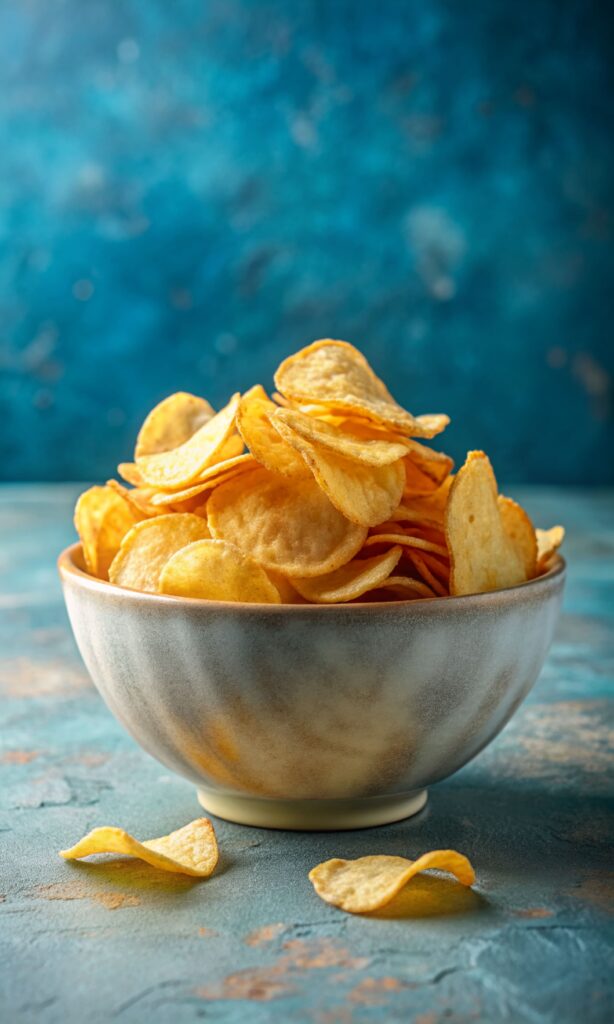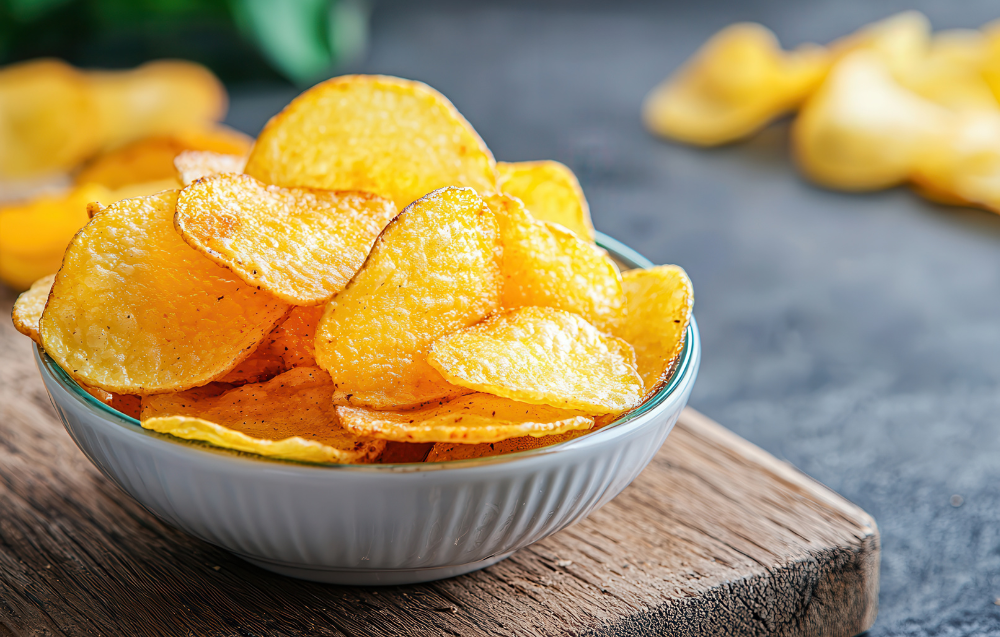The secret of making good chips lies in their crispy, golden, and utterly addictive nature. Whether you’re snacking on them at a party, serving them alongside a burger, or indulging in a midnight craving, chips hold a special place in our hearts (and stomachs). But what if I told you that making good chips—no, great chips—isn’t as mysterious as it seems? With a bit of know-how and a sprinkle of patience, you can whip up chips that rival any restaurant’s offering. Let’s dive into the crispy world of chip-making secrets.
Introduction to Perfect Chips
Why Chips Are a Universal Favorite
Think about it—the secret of making good chips is why they’re everywhere. From fast food joints to five-star restaurants, they’re a staple side dish and snack. Why? Because they hit all the right notes: crunch, saltiness, and just enough fluff on the inside to keep you coming back for more. But as common as they are, not all chips are created equal. Some are too greasy, others too soggy, and let’s not even start on the ones that are bland. So, what makes chips so irresistible when done right? It’s all about balance—getting that perfect crispiness without sacrificing flavor.

Choosing the Right Ingredients
Selecting the Best Potatoes for Chips
Not all potatoes are made for chips, and understanding this is key to mastering the secret of making good chips. If you’ve ever wondered why your homemade chips didn’t turn out quite right, it could be the spuds you’re using. For the best results, stick to starchy potatoes like Russets or Maris Piper. Why? Because their high starch content and low moisture level help achieve that iconic crispy texture. Avoid waxy potatoes—they’re better suited for salads than for frying.
If you’re a fan of exploring unique textures in food, you might enjoy this guide on how to make any chip spicy. It’s a great way to add a bold twist to your snack game.
“The potato you pick is the foundation of your chips. Choose wisely, and you’re halfway to perfection.”
Oils That Enhance Flavor and Texture
Oil isn’t just a medium to fry your chips; it’s a critical part of the secret of making good chips. Neutral oils like vegetable, canola, or sunflower oil are great choices because they don’t overpower the natural taste of the potato. If you’re feeling adventurous, try peanut oil for a slightly nutty flavor or avocado oil for a healthier twist. Always use fresh oil—old oil can ruin your chips with an unpleasant aftertaste, robbing them of their potential crispiness and flavor.
Importance of Seasoning in Chips
Here’s where you can get creative—seasoning is a big part of the secret of making good chips. A sprinkle of salt is classic, but why stop there? Paprika, garlic powder, or even a dash of chili flakes can elevate your chips to gourmet status. Just make sure to season them while they’re hot; this ensures the spices stick better, locking in flavor and taking your chips to the next level.
The Science of Frying Chips
Temperature Control: A Key to Crispy Chips
Here’s the deal: frying chips is a critical step in the secret of making good chips—and it’s more of a science than a simple task. The oil needs to be at the right temperature—usually around 350°F to 375°F (175°C to 190°C). Too low, and your chips soak up the oil, turning greasy and unappealing. Too high, and they burn on the outside while staying raw inside. Investing in a thermometer if you don’t already have one is a game-changer for achieving perfectly crispy chips every time.
Want to learn how to elevate your chips to the next level? Check out the spicy chips guide for an exciting flavor boost that complements their crunch.
Double Frying Method: Myth or Magic?
Ever heard of double frying? It’s not a gimmick; it’s a proven technique that chefs swear by. The first fry (at a lower temperature, around 325°F/160°C) cooks the potato through. The second fry (at a higher temperature, around 375°F/190°C) crisps up the exterior. The result? Chips that are soft on the inside and perfectly crispy on the outside.
“The double-frying method is like giving your chips a second chance to shine. Don’t skip it if you’re aiming for perfection.”
Common Mistakes to Avoid When Frying Chips
Let’s save you some heartache. Here are the most common frying mistakes:
- Overcrowding the pan: This drops the oil temperature, leading to soggy chips.
- Skipping the soak: Potatoes need a cold water bath to remove excess starch, ensuring they fry evenly.
- Using the wrong pot: Always choose a deep, heavy-bottomed pot to maintain consistent oil temperature.
Techniques for Perfect Chips
Hand-Cut vs. Machine-Cut Chips: Pros and Cons
There’s something charming about hand-cut chips—they’re rustic and unique in shape. But they can be uneven, leading to inconsistent cooking. Machine-cut chips, on the other hand, offer uniformity, which is great for ensuring every chip fries evenly. Choose what works best for you; both methods have their merits.
Soaking and Rinsing: A Step Often Overlooked
If you’re tempted to skip this step, don’t—it’s a vital part of the secret of making good chips. Soaking your potato slices in cold water for at least 30 minutes removes excess starch, preventing them from clumping together or becoming gummy during frying. After soaking, rinse them thoroughly to eliminate any lingering starch and dry them completely. Remember, moisture and hot oil don’t mix—that’s a recipe for splattering disasters and unevenly cooked chips. This simple step ensures crisp, golden perfection every time.
How to Achieve the Perfect Crunch
Crunchy chips are all about technique, and mastering it is essential to the secret of making good chips. Begin by slicing your potatoes thin and evenly to ensure consistent cooking. Fry them in small batches to avoid overcrowding, and always pat them dry before frying to prevent oil splatters and soggy results. Here’s a pro tip: after frying, lay your chips on a wire rack instead of paper towels. This prevents them from steaming, helping them retain their satisfying crunch and making every bite irresistible.
Healthier Alternatives to Traditional Chips
While nothing beats the indulgence of deep-fried chips, healthier options are gaining popularity. If you’re looking to satisfy your chip cravings without the guilt, here are some alternatives that deliver on taste and texture.
Baking Chips Instead of Frying
Who says chips need to be fried to be crispy? Baking is a fantastic alternative that requires minimal oil. Here’s how to do it:
- Slice your potatoes thinly: Uniformity is key.
- Toss in a little oil: A tablespoon or two is enough.
- Spread evenly on a baking tray: Avoid overcrowding to ensure even baking.
- Bake at 400°F (200°C): Flip halfway through for consistent browning.
The result? Crispy, golden chips that are lighter but still pack a crunch. Bonus: baked chips are lower in calories and fat.
For those using cast iron pans for baking, make sure to properly clean and maintain your cast iron skillet. A well-maintained skillet ensures even heating and prevents sticking.
Using Air Fryers for Low-Fat Chips
If you’re serious about cutting down on oil without sacrificing crispiness, an air fryer is your ultimate ally and a key part of the secret of making good chips. These modern gadgets circulate hot air around your food, perfectly mimicking the effect of deep frying with just a fraction of the oil. The process is simple: lightly coat your potato slices in oil, arrange them in the air fryer basket, and let the hot air work its magic. The result? Crispy, golden chips that are healthier yet every bit as delicious.
- Preheat your air fryer.
- Lightly coat the potato slices in oil.
- Fry in small batches to allow even airflow.
Air-fried chips are crispy on the outside and tender on the inside—a healthier twist on the classic.
Adding Nutritional Value with Alternative Ingredients
Potatoes may be classic, but don’t shy away from experimenting with other nutrient-dense ingredients:
- Sweet potatoes: Rich in fiber and vitamin A, they’re a healthier option that still delivers a sweet and satisfying crunch. Learn more about the nutritional benefits of sweet potatoes.
- Beets and carrots: For a colorful twist, these root vegetables make visually stunning and flavorful chips.
- Zucchini or kale: Perfect for low-carb alternatives that are as crispy as they are nutritious.
Flavoring Secrets for Irresistible Chips
What sets homemade chips apart from store-bought ones? Flavor. Here’s how you can level up your chips with creative seasoning and dips. like this article on best sauces for shrimp. While it focuses on shrimp, the principles of flavor balancing can easily apply to dips for your chips.
Infusing Chips with Unique Spice Blends
Salt is a classic, but why stop there? Create your own spice blends to give your chips a personality. Here are a few ideas:
- Smoky paprika and garlic powder for a barbecue vibe.
- Rosemary and sea salt for an herby, sophisticated twist.
- Curry powder and cumin for an exotic, warm flavor.
For a deeper dive into achieving perfect frying results, understanding the science of oil temperature is crucial. This knowledge ensures your chips fry evenly and don’t absorb excess oil.
“Your chips should be a canvas for flavor experimentation. Don’t be afraid to get creative!”
Gourmet Toppings to Elevate Your Chips
Toppings aren’t just for nachos—they’re an exciting part of the secret of making good chips. A sprinkle of grated parmesan, a drizzle of truffle oil, or a handful of freshly chopped herbs can instantly elevate your chips into a gourmet snack. Think of it as dressing up your chips for a special occasion, adding flair and flavor that makes them irresistible.
Creating Dips to Complement Your Chips
No chip is complete without the perfect dip. Here are a few must-try combinations:
- Garlic aioli: Rich and creamy, a perfect partner for crispy chips.
- Spicy sriracha mayo: For those who like it hot.
- Herb yogurt dip: Light and refreshing, with dill or mint.
Serve these dips alongside your chips for a pairing that’s as satisfying as peanut butter and jelly.
Common Problems and Solutions in Chip Making
No one wants to spend time making chips only to have them turn out less than perfect. Here’s how to troubleshoot the most common chip-making issues.
Chips Too Soggy: Causes and Fixes
Soggy chips are a disappointment, but they’re also avoidable. The culprit? Usually, it’s moisture or incorrect oil temperature. Here’s how to fix it:
- Dry your potatoes thoroughly after rinsing.
- Don’t overcrowd the fryer. Fry in small batches to maintain oil temperature.
- Keep the oil hot. Use a thermometer to ensure it stays at the optimal frying temperature.
Overly Greasy Chips: How to Prevent This
Greasy chips are the result of oil absorption, which happens when the frying temperature is too low. To avoid this:
- Heat your oil to at least 350°F (175°C) before adding the potatoes.
- Use paper towels or a wire rack to drain excess oil after frying.
“Greasy chips are like soggy cereal—they ruin the experience. The right oil temperature is your best defense.”
Uneven Cooking: Tips for Consistency
Ever bite into a chip that’s burnt on one side and raw on the other? This usually happens because of uneven slicing or frying. Here’s how to fix it:
- Use a mandoline slicer for uniform slices.
- Stir the chips occasionally while frying to ensure even exposure to the heat.
- Fry in small, manageable batches.
Regional Variations in Chip Making
Chips might be universal, but the way they’re made varies significantly across cultures. Exploring these differences can inspire your next batch.
Exploring French Fries vs. British Chips
In the U.S., thin and crispy fries are the gold standard, while in the U.K., the secret of making good chips leans toward a thicker cut that’s soft and fluffy on the inside. British-style chips are often served with a sprinkle of malt vinegar, adding a tangy twist to their hearty texture. Both styles have their unique charm, and the best part? You can try making both at home to discover which one wins your heart.
Popular Chip Styles Around the World
- Belgian fries: Thick-cut and fried in beef tallow for extra flavor.
- Pomme soufflée (France): Puffy, hollow chips that are a work of art.
- Patatas bravas (Spain): Crispy potato cubes served with spicy tomato sauce.
What Makes Each Style Unique
The secret lies in the technique. Belgian fries owe their flavor to beef tallow, while patatas bravas are finished with a sauce that adds a whole new layer of taste. Trying these regional styles can broaden your chip horizons.
The Economics of Homemade vs. Store-Bought Chips
When it comes to chips, convenience often wins. Store-bought options are quick and easy, but are they truly better than homemade ones? Let’s break it down.
Cost Analysis of Homemade Chips
Making chips at home might seem expensive upfront, especially if you invest in tools like a mandoline slicer or an air fryer, but it’s a key part of the secret of making good chips. In the long run, the savings are significant. A bag of potatoes costs far less than a bag of premium chips, and you can make multiple batches from a single purchase. Plus, making chips at home gives you full control over the quality of ingredients, ensuring a healthier, fresher, and tastier snack every time.
Here’s a quick breakdown:
- Homemade Chips: ~$0.50 per serving (including oil and seasoning).
- Store-Bought Chips: ~$2–$5 per bag, often with fewer servings.
Over time, those savings add up, especially if chips are a household staple.
Taste and Quality Comparison
Store-bought chips might offer consistency, but they often come loaded with preservatives and artificial flavors. Homemade chips, however, are a cornerstone of the secret of making good chips. They boast a freshness and depth of flavor that’s nearly impossible to replicate. Plus, the texture is entirely customizable—whether you prefer thick and fluffy or thin and crispy, making them at home gives you full control to craft chips exactly the way you love them.
Environmental Impact of Homemade Chips
Making chips at home is an essential part of the secret of making good chips and is also kinder to the planet. Store-bought chips often come with excess packaging waste, contribute to transportation emissions, and bear the environmental cost of mass production. By choosing to make your chips at home, you not only enjoy a fresher, superior product but also reduce your carbon footprint, proving that great taste and sustainability can go hand in hand.
“Homemade chips aren’t just better for you—they’re better for the planet too.”
Tips from Experts for Making Good Chips
Even seasoned cooks sometimes struggle to get their chips just right. That’s where expert advice comes in handy. Here are some tips from chefs and home cooks who’ve mastered the art of chip-making.
Insights from Professional Chefs
Professional chefs know the importance of precision:
- Use a thermometer: Consistent oil temperature is non-negotiable.
- Rest after frying: Let your chips rest for a minute or two before the second fry. This helps them crisp up beautifully.
- Experiment with oils: Peanut or duck fat can add a luxurious touch to your chips.
Learning from Home Cooks and Experimenters
Home cooks often come up with innovative hacks:
- Microwave trick: Preheat your sliced potatoes in the microwave for 1–2 minutes before frying to speed up the cooking process.
- Seasoning layering: Sprinkle seasoning in stages—once after frying and again before serving for a deeper flavor.
- Ice water soak: After cutting your potatoes, soak them in ice water instead of just cold water. It tightens the potato fibers, leading to an extra-crispy result.
“The beauty of making chips at home is that you can combine science and creativity to discover your perfect recipe.”
Must-Have Tools for Chip Enthusiasts
If you’re serious about chips, a few tools can make all the difference:
- Mandoline slicer: For perfectly even slices.
- Deep fryer: For maintaining consistent temperatures.
- Wire rack: To let chips cool without steaming.
Conclusion: The Secret to Making Perfect Chips
Recap of Key Tips and Techniques
Let’s quickly recap what we’ve covered:
- Choose the right potatoes: Starchy varieties like Russets are your best bet.
- Master the frying process: Double frying and temperature control are critical.
- Experiment with flavors: Spice blends, gourmet toppings, and dips can elevate your chips.
- Explore alternatives: Baked and air-fried chips are great for healthier options.
- Learn from mistakes: Soggy, greasy, or uneven chips all have simple fixes.
“The secret to great chips isn’t in a fancy recipe—it’s in understanding the process and making it your own.”
Encouragement to Experiment and Innovate
Making chips is as much about creativity as it is about mastering the secret of making good chips. Don’t be afraid to experiment with new ingredients, explore international styles, or put your own spin on classic recipes. Each batch is an opportunity to learn, refine your technique, and discover new flavors. Remember, the journey to perfect chips is just as rewarding as the crispy, golden destination.
So, are you ready to make the best chips of your life? Grab your potatoes, fire up your oil (or air fryer), and get cooking. The secret to great chips isn’t just in the recipe—it’s in your hands.

